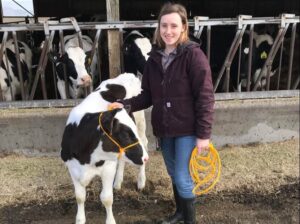International Women’s Day celebrates the social, economic, and cultural achievements of women. It is a moment to look back on the strides that women have made in achieving gender parity and equality, and a look ahead to how far they still have to go.
For the 2021 observance of International Women’s Day on March 8, women innovators and educators in WSU’s College of Agricultural, Human, and Natural Resource Sciences reflected on those gains and the road ahead.
According to the 2017 Census of Agriculture, more than half of all U.S. farms, or 56%, have at least one woman grower. Women are more likely to live on farms than their male counterparts. Women producers are slightly younger, and more likely to be a new farmer.
Women-operated farms account for 38% of U.S. agriculture sales, and 43% of U.S. farmland.
While the total number of U.S. producers increased by 7% between 2012 and 2017, the number of woman producers increased by 27%. Washington is one of the top states for women in agriculture, with 42% women producers.
“Across quite a bit of agriculture, we are seeing a lot more women joining the workforce,” said Amber Adams-Progar, associate professor and dairy management specialist for WSU’s Department of Animal Sciences.
Adams-Progar serves on a Woman’s Advisory Council known as AgriSafe, an organization that works with producers to improve health and safety in agriculture.
“As women increasingly started joining the world of agriculture, employers have had to take things into consideration that they haven’t before,” she said.
AgriSafe creates safety training materials specifically for women farmers and farm workers.
“There’s now enough attention to say, ‘How can we help women workers be safer and enjoy their jobs more?’” Adams-Progar said.
Opportunities in academia

Colette Casavant, director of student success for CAHNRS, said WSU’s women student enrollment in Agricultural and Food Systems remained steady through the 2016 – 2021 academic years.
Agricultural Education carries the highest ratio of women students, while Agricultural Technology and Production Management (AgTM) carried the lowest.
“There are certainly growth opportunities for women students in AgTM. This major traditionally attracts students interested in ‘returning to the family farm,’ or pivoting to agricultural production management, consulting, or sales,” Casavant said.
“In academia, women remain underrepresented in the field of agricultural economics, and in economics generally,” said Jill McCluskey, director and Regents Professor for WSU’s School of Economic Sciences.
“I’m the first economics department chair or director who is a woman, and only the third woman hired in the history of agricultural economics at WSU,” she said.
While the student population in her department is still majority men, the number of women faculty and staff at the school has grown.
“We’ve been more successful at recruiting women at the graduate level,” she said.
The first woman faculty member hired by the WSU Department of Agricultural Economics was Vicki McCracken in 1984. She’s now the associate dean and director of Washington State University Extension.
Over her nearly 40-year career at WSU, McCracken has watched the role of women in agriculture change from being a key support person on the family-owned farm to pushing to lead innovation and change.
“Higher education has played an important role in empowering women to take on leadership roles in agriculture,” she said.
Resources for WSU women
The WSU Women*s Center, founded in 1912 as the Association for Women Students, has a mission to elevate marginalized voices and challenge patterns of injustice. The asterisk was added in 2018 to make clear that all genders are welcome to participate in programs and activities.
Amy Sharp, director of the Center, said the goal is to provide a space and opportunity for students to come together and talk about issues they’re facing, and get advice from peers, mentors, and advisors.
“We have students that come from agricultural backgrounds who have worked in the fields. It’s our job to explain that someday, those women can own the fields,” she said.
Learn more about WSU’s College of Agricultural, Human, and Natural Resource Science degrees and career opportunities.
Discover more about WSU’s Women*s Center and their programs and services.






